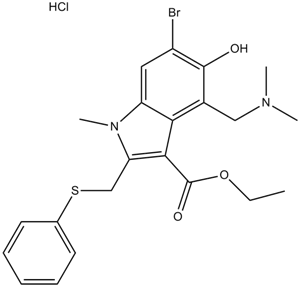Arbidol HCl (Synonyms: Umifenovir hydrochloride) |
| Catalog No.GC13979 |
Arbidol HCl is a potent, orally active broad-spectrum antiviral with activity against a number of enveloped and non-enveloped viruses.
Products are for research use only. Not for human use. We do not sell to patients.

Cas No.: 131707-23-8
Sample solution is provided at 25 µL, 10mM.
Arbidol hydrochloride (Umifenovir hydrochloride) is an broad-spectrum antiviral chemical agent which can inhibit cell entry of enveloped viruses by blocking viral fusion with host cell membraneIC50 value:Target: Antiviral; Anti-influenza agentin vitro: Arbidol was found to present potent inhibitory activity against enveloped and non-enveloped RNA viruses, including FLU-A, RSV, HRV 14 and CVB3 when added before, during, or after viral infection, with 50% inhibitory concentration (IC50) ranging from 2.7 to 13.8 microg/ml.However, arbidol showed selective antiviral activity against AdV-7, a DNA virus, only when added after infection (therapeutic index (TI) = 5.5) [1]. Arb interacts with the polar head-group of phospholipid at the membrane interface. Fluorescence studies of interactions between Arb and either tryptophan derivatives or membrane peptides reconstituted into liposomes show that Arb interacts with tryptophan in the micromolar range. Interestingly, apparent binding affinities between lipids and tryptophan residues are comparable with those of Arb IC50 of the hepatitis C virus (HCV) membrane fusion [2]. Arbidol not only prevented the cytopathic effect (CPE) of CVB(5), as demonstrated in an MTT colorimetric assay, when added during or after viral infection, with a 50% inhibitory concentration (IC(50)) from 2.66 to 6.62 microg/ml, but it also decreased the CVB(5)-RNA level in infected host cells, as shown in semi-quantitative RT-PCR [3].in vivo: Orally administered arbidol at 50 or 100 mg/kg/day beginning 24 h pre-virus exposure for 6 days significantly reduced mean pulmonary virus yields and the rate of mortality in mice infected with FLU-A (A/PR/8/34 H1N1) [1]. BALB/c mice were used as an animal model to test the Arbidol activity in vivo. Orally administered Arbidol at 50 mg/kg body weight/day (once a day) significantly reduced mean virus yields in the lungs and heart as well as mortality after infection for 6 days [3].
References:
[1]. Shi L, et al. Antiviral activity of arbidol against influenza A virus, respiratory syncytial virus, rhinovirus, coxsackie virus and adenovirus in vitro and in vivo. Arch Virol. 2007;152(8):1447-55.
[2]. Teissier E, et al. Mechanism of inhibition of enveloped virus membrane fusion by the antiviral drug arbidol. PLoS One. 2011 Jan 25;6(1):e15874.
[3]. Zhong Q, et al. Antiviral activity of Arbidol against Coxsackie virus B5 in vitro and in vivo. Arch Virol. 2009;154(4):601-7.
Average Rating: 5 (Based on Reviews and 25 reference(s) in Google Scholar.)
GLPBIO products are for RESEARCH USE ONLY. Please make sure your review or question is research based.
Required fields are marked with *




















